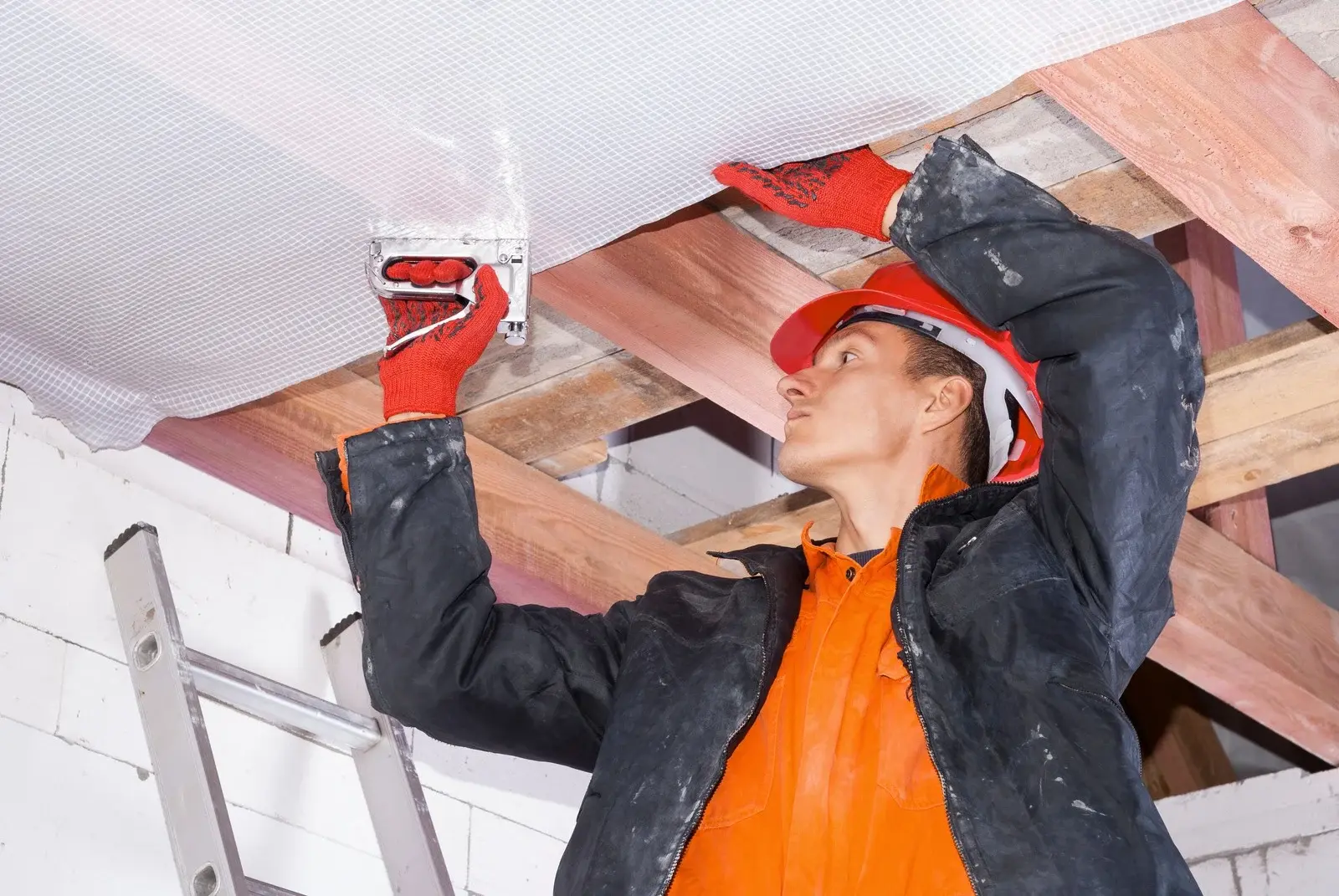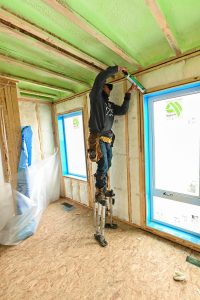Creating a comfortable, energy-efficient home starts with one critical factor: the building envelope. The right materials form the shield that separates indoor comfort from outdoor conditions, keeping heat where you want it and moisture where you don’t.
Avalon Homes prioritizes high-performance building envelope systems that reduce energy costs, improve air quality, and extend the lifespan of your home. Every material choice matters. From the membranes behind your walls to the windows that frame your view.
In this guide, we’ll walk through the most common building envelope materials and explain how Avalon Homes uses them to deliver superior results.
Air Barrier Systems
A continuous air barrier is the backbone of an energy-efficient home. Without it, conditioned air leaks out, moisture seeps in, and energy bills skyrocket.
- Housewrap and Weather Barriers: Products like Tyvek and Typar are breathable membranes that block windand rain while allowing vapor to escape, preventing trapped moisture.
- Liquid-Applied Air Barriers: Perfect for complex wall geometries, spray-on barriers create seamless protection with no gaps or overlaps.
- Self-Adhered Membranes: Peel-and-stick solutions are ideal for foundations, window openings, and other high-risk areas.
- Tape and Sealant Systems: Even the best air barrier fails without properly sealed joints and penetrations.
Avalon’s Approach
We pair premium weather membranes with professional-grade sealants and rigorous installation techniques to ensure a truly airtight envelope, every time.
Insulation Materials for High Performance
Insulation is the thermal shield of your home. It slows heat flow to reduce energy demands year-round.
 Continuous Insulation: We have moved away from standard rigid foam board. We now use BTRBoard, a high-performance, medium-density polyurethane foam. This innovative material provides a higher R-value per inch, resulting in superior thermal resistance (minimizing heat loss). This leads to a more consistent indoor temperature and significantly reduced reliance on heating and cooling systems for our homeowners.
Continuous Insulation: We have moved away from standard rigid foam board. We now use BTRBoard, a high-performance, medium-density polyurethane foam. This innovative material provides a higher R-value per inch, resulting in superior thermal resistance (minimizing heat loss). This leads to a more consistent indoor temperature and significantly reduced reliance on heating and cooling systems for our homeowners.- Cavity Insulation: For clarity, we do not use blown-in cellulose in stud bays. Our approach combines the continuous exterior BTRBoard with optimized cavity insulation (Fiberglass batts) to achieve our target R-values and eliminate thermal bridging.
- High-Performance Options: For extreme efficiency, materials like vacuum-insulated panels and aerogels offer unparalleled thermal performance.
- Thermal Bridge Prevention: Insulated sheathing and thermal breaks prevent heat from bypassing the insulation layer.
Avalon’s Approach
Our team uses a combination of continuous exterior BTRBoard and optimized fiberglass batt cavity insulation to achieve target R-values and eliminate weak points in the thermal envelope.
Vapor Control and Moisture Management
A tight home must also be dry. Poor moisture management leads to mold, rot, and poor indoor air quality.
- Vapor Barriers vs. Retarders: In Canada’s varied climates, permeability must be carefully chosen tobalancevapor diffusion and drying potential.
- Smart Vapor Barriers: These membranes adjust permeability based on seasonal humidity, offering the best of both worlds.
- Drainage Planes and Rainscreens: Creating a drainage gap behind siding ensures that any water that gets in can get out.
- Foundation Waterproofing: Below-grade membranes and drainage systems keep basements dry and durable.
Avalon’s Approach
We use climate-appropriate vapor control strategies, rainscreen cladding systems, and robust drainage details to protect the structure for decades.
Window and Door Systems
Fenestration (windows, doors, and related openings) is a key part of the envelope and one of the biggest potential sources of heat loss.
- High-Performance Windows: Triple-pane glazing, low-E coatings, and argon gas fills deliver excellent thermal performance.
- Proper Installation: Flashing, shimming, and sealing are just as important as the window itself.
- Efficient Door Systems: Insulated door cores, quality weatherstripping, and threshold design prevent drafts.
- Advanced Glazing Technologies: Warm-edge spacers and thermally broken frames reduce condensation and heat loss.
Avalon’s Approach
We source premium windows and doors, install them to industry best practices, and verify performance with blower door testing.
Advanced Envelope Technologies
Cutting-edge solutions are changing the way builders approach envelope design.
- SIPs (Structural Insulated Panels): Combine structure, insulation, and sheathing into one panel for superior efficiency.
- ICFs (Insulated Concrete Forms): While not our standard system, it’s exciting to note that we are utilizing ICFs for our Belmont project. This allows us to leverage the exceptional durability and thermal mass benefits of concrete in that specific design.
- Prefabricated Wall Systems: Factory-built panels with pre-installed air and vapor barriers improve precision and reduce site waste.
- Advanced Systems: Rather than phase-change or dynamic insulation systems, we focus on the tangible benefits of the advanced systems we use, like our premium air and vapor barriers and high-performance windows, which collectively automate temperature and moisture regulation in a way that’s easy for homeowners to understand.
Avalon’s Approach
We continually evaluate and adopt proven innovations that enhance comfort, durability, and efficiency in our homes.
Quality Control and Testing
The best materials mean little without proper installation and verification.
- Blower Door Testing: Identifies air leakage and verifies airtightness targets are met.
- Thermal Imaging: Reveals hidden insulation gaps and thermal bridges.
- Installation Standards: Strict adherence to manufacturer specs ensures long-term performance.
Avalon’s Approach
Every home undergoes performance testing and quality checks so clients know their home will meet (and often exceed) efficiency standards.
Selecting the right building envelope materials is one of the most important decisions when it comes to modern home construction. A well-designed envelope improves comfort, lowers energy bills, and ensures long-term durability.
Ready to build smarter? Contact Avalon Homes today to schedule a consultation and discover how our advanced building envelope solutions can make your next home more comfortable, efficient, and future-ready.



 Continuous Insulation: We have moved away from standard rigid foam board. We now use BTRBoard, a high-performance, medium-density polyurethane foam. This innovative material provides a higher R-value per inch, resulting in superior thermal resistance (minimizing heat loss). This leads to a more consistent indoor temperature and significantly reduced reliance on heating and cooling systems for our homeowners.
Continuous Insulation: We have moved away from standard rigid foam board. We now use BTRBoard, a high-performance, medium-density polyurethane foam. This innovative material provides a higher R-value per inch, resulting in superior thermal resistance (minimizing heat loss). This leads to a more consistent indoor temperature and significantly reduced reliance on heating and cooling systems for our homeowners.